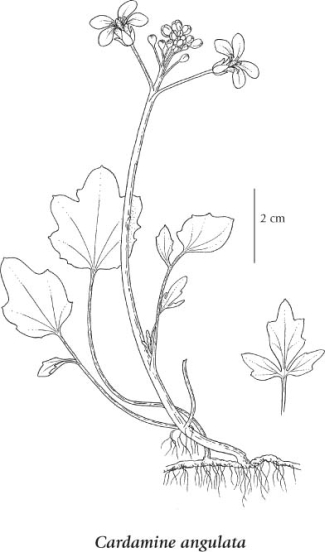Cardamine angulata Hook.
angled bitter-cress (seaside bittercress)
Brassicaceae (Mustard family)
Introduction to Vascular Plants
angled bitter-cress (seaside bittercress)
Brassicaceae (Mustard family)
Introduction to Vascular Plants
Photograph
© Dave Ingram (Photo ID #227)
Species Information
General:
Perennial herb from slender rhizome, greater than 3 cm long, not tuberous; stems simple, 40-80 cm tall, glabrous or sparsely hairy.
Leaves:
With 3-5 leaflets, long-stalked, leaflets narrowly egg-shaped to egg-shaped, widely toothed to lobed, the terminal leaflet 1.5-5 cm long, 1.2-3 cm wide, somewhat larger than the lateral ones, hairy-fringed; upper stem leaves egg-shaped, with 3-5 large teeth.
Flowers:
Inflorescence a simple raceme; flower stalks 8-20 mm long, ascending, glabrous; petals white to pinkish, 8-14 mm long; sepals pale yellow-green, about 2 mm long.
Fruits:
Siliques, 1.5-3.5 cm long, 1.5-2 mm wide, erect, glabrous; styles 1.5-3 mm long.
Illustration

If more than one illustration is available for a species (e.g., separate illustrations were provided for two subspecies) then links to the separate images will be provided below. Note that individual subspecies or varietal illustrations are not always available.
Illustration Source: The Illustrated Flora of British Columbia
Ecology
Ecological Framework for Cardamine angulata
The table below shows the species-specific information calculated from
original data (BEC database) provided by the BC Ministry of Forests and Range.
(Updated August, 2013)
The table below shows the species-specific information calculated from
original data (BEC database) provided by the BC Ministry of Forests and Range.
(Updated August, 2013)
| Site Information |
Value / Class |
||
|
Avg |
Min |
Max |
|
| Elevation
(metres) |
238 | 50 | 575 |
| Slope
Gradient (%) |
10 | 0 | 45 |
|
Aspect (degrees) |
180 | 45 | 225 |
| Soil
Moisture Regime (SMR) [0 - very xeric; 4 - mesic; 8 - hydric] |
5 | 4 | 7 |
| Modal
Nutrient Regime
Class |
D | ||
| #
of field plots species was recorded in: |
5 | ||
| Modal
BEC Zone Class |
CWH | ||
|
All BEC Zones (# of stations/zone) species was recorded in |
CWH(5) | ||
|
Source:
Klinkenberg 2013
|
|||